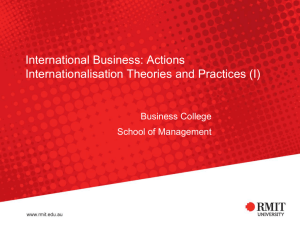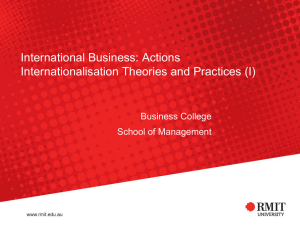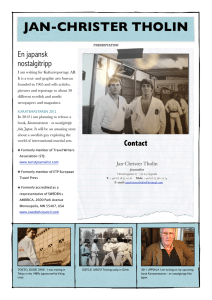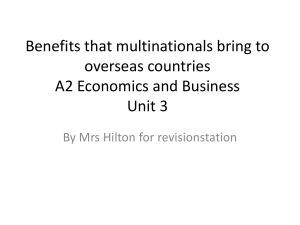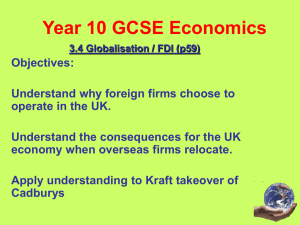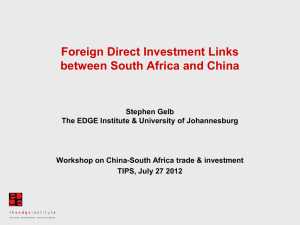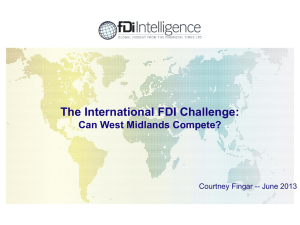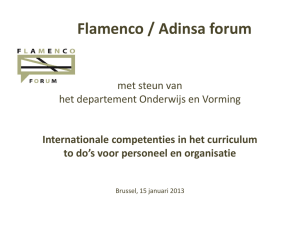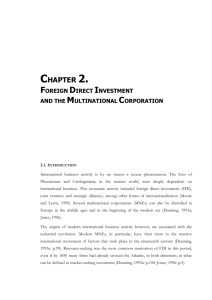simibtopic4
advertisement
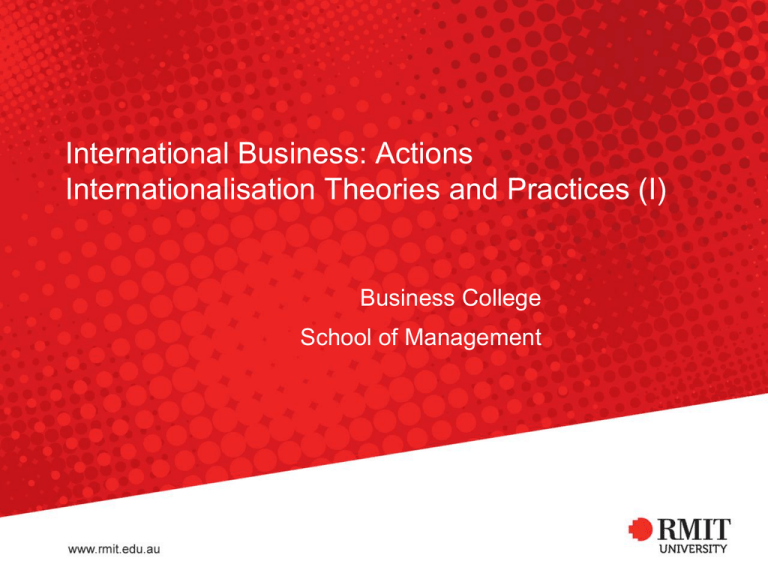
International Business: Actions Internationalisation Theories and Practices (I) Business College School of Management Key Learning Objective • This session will help you to understand the concepts of: 1) Foreign Direct Investment 2) Key internationalisation theories – Uppsala Model 3) Dunning’s OLI Paradigm Key Questions • What approaches to global strategy do firms take? • How do organisations internationalise? • How does international business manage its internal operations globally? • How does international business manage its external operations (e.g. relationship with the host country/communities)? Internationalisation? • What factors are driving the internationalisation processes of these companies? BHP Expansion and Pacific Brands Offshoring http://www.youtube.com/watch?v=TiaNjJNIDkg http://www.youtube.com/watch?v=BpiC-FSid7w WHY HAVE AN INTERNATIONALISATION STRATEGY? Ghoshal (1987) • Becoming multinational to search a competitive advantage: – National differences: Exploiting national differences in factor costs – Scale Economies – Scope Economies FOREIGN DIRECT INVESTMENT 1 – How does it work? RMIT University School of Management 6 Foreign Direct Investment (FDI) • An investment into production or business in a country by a company in another country, either by buying a company in the target country or by expanding operations of an existing business in that country (Kelly, 2011). • an investment in controlling and managing value-added activities in other countries (Peng and Meyer, 2012). • an investment made to acquire lasting interest in enterprises operating outside of the economy of the investor (UNCTAD, 2009). Activity 1: FDI in Africa • Please watch this clip https://www.youtube.com/watch?v=jofzYoAqbsw And discuss ‘why FDI in Africa has been growing continuously?’ RMIT University School of Management 8 MNCs and FDI • Zara would not be an MNC if it manufactured all its clothes in Spain and exported them around the world. Zara became an MNC only when it started to directly invest abroad, for instance in shops and distribution centres in Australia, Japan or Singapore (Peng and Myer, 2012). What is the major concern of 506 executives wanting to invest in India? Why is this important to the internationalisation of your business? Source: UNCTAD, 2012 Between 2007 and 2011, a total of 1,243 foreign direct investment (FDI) projects were recorded in Australia from 933 companies. This represents an average annual growth rate of 15.4 per cent with a total capital investment of US$122 billion. Greenfield investments accounted for 84.8 per cent of projects over this five year period. (Brisbane Marketing, 2012) FDI in Australia (Source: ABS, 2011) Industry $Million % share of total FDI Mining 151,065 31.9 Manufacturing 88,481 18.7 Finance 67,653 14.3 Wholesale and Retails 44,500 9.4 Transport and Communication 43,331 5.3 Statistics – FDI INFLOWS: FDI and its relationship with Internationalisation Statistics – FDI OUTFLOWS: UNCTAD (2009) FDI…Poison or Panacea? • FDI allows money to freely go to whatever business has the best prospects for growth anywhere in the world. • Too much foreign ownership of MNCs can be a concern, especially in industries that are strategically important. • Investors receive additional benefits. Their risk is reduced because they can diversify their holdings outside of a specific country, industry or political system. • The risk factors are always the major concern among MNCs. • The standard of living in the recipient country is also improved by higher tax revenue from the company that received the foreign direct investment. Activity 2: Actors in FDI • Please watch this story from the Villar Mir group, a French company in Spain and identify (1) ‘actors’ in Foreign direct investment and (2) key issues for the management team of an MNC prior to the decision to embark on the FDI in the new country. http://www.youtube.com/watch?v=5vA6rzUyyu4 INTERNATIONALISATION THEORIES RMIT University©yyyy School/Department/Area 18 Literature on MNCs and Internationalisation • Mainstream MNC Theories After the Second World War, the rapid development of MNCs and their FDI caused widespread interest among Western scholars. They adopted different research methods and created basic assumptions towards different research objects, and consequently created various MNC theories. The Uppsala Model The basic information: it developed by Johanson & Wiedershiem-Paul in 1975 at Uppsala University. Complemented by Johanson & Vahlne in 1977. Empirical bases: Four Swedish Companies: Volvo, Sandvik, Atlas Copco, and Facit The model was made in accordance with the entry form and the choice of the market of these Swedish firms. The main description: The Uppsala model is a theory that explains how firms gradually intensify their activities in foreign markets. The Uppsala Internationalisation Model • Swedish manufacturing companies begin their internationalisation process by establishing in the Nordic countries. • According to the stage model the Swedish researchers stressed that Swedish manufacturing companies began to operate abroad in a nearby market and then slowly penetrated markets far away. This model was developed in the 1970s and has lately been criticised for no longer being relevant. The Uppsala Model The Uppsala Model Market Knowledge Market Commitment Commitment Decision -General Knowledge -Amount of resources -Marketing methods -Size of investment (marketing, organisation) -Perceived opportunities and problems in a specific market -Degree of commitment -The economic effect -Alternative use for the committed resources and transferring them into the alternative one - Psychic Distance -Common characteristics of customers -Business Culture -Climate, customer firms personal Source: Johanson & Vahlne (1977) The Uppsala Model • A basic assumption of the model is that lack of knowledge about foreign markets is a major obstacle to internationalization, but that this obstacle can be overcome through learning about foreign market conditions. • The firm’s own current operations are the main source of this kind of learning. In turn, this reasoning leads to a second assumption of “learning by doing” (cf. Lindblom, 1959; and Johnson, 1988). • Investment decisions and actual investment commitments are made incrementally as uncertainty is successively reduced. • The more the firm knows about a foreign market, the lower the perceived market risk will be and, consequently, the higher the actual investment by the firm in that market tends to be. Criticisms • The Uppsala internationalisation model has been criticized as deterministic (Reid, 1981) and, if firms were to develop in accordance with the model, individuals would then have no strategic choices (Andersson, 2000). • Another bigger challenge is that today many firms simply do not follow the traditional pattern of internationalisation proposed by stage theory. Some firms are international from their birth and have been called: international new ventures (Oviatt and McDougall, 1994, 1995), born global (Madsen and Servais, 1997), and global start-ups (Oviatt and McDougall, 1995). Activity 3: Uppsala Model in Context [Evaluate] • Please discuss the concept of Uppsala model in your team and list 3 factors that may change the application of the model in modern international business. • Do you think it is still an effective model? • Can you think of any industry where it still may apply? • What has changed this? DUNNING’s Electic Paradigm – Why do firms become multinational? • One of the dominant frameworks for explaining the existence of MNCs and the determinants of FDI • O = Ownership • L = Location • I = Internalisation *Note: The modern paradigm of OLI is well discussed in Dunning and Lundan (2008), Institutions and the OLI paradigm of the Multinational Enterprise, Asia Pacific Journal of Management, 25:573-593. Ownership • The firm that invests abroad has a competitive advantage (to exploit) and outcompete the firms that operate in the country where the investment is done. – Economies of scale connected to large-sized company – Possess technologies that give an advantage on the subsidiary abroad – Monopolistic advantages in terms of priviledged access to inputs or outputs markets – Skills of management Location • Advantages of the foreign location: – Different nations have different factor endowments: – Natural resources – Cheap labour force – Skills and capabilities – Country characteristics (political stability, regulations, cultural distance) Bolivia happens to possess up to 54% of the world's Lithium deposits Underneath the salt lies the world's largest lithium reserves Internalisation NOTE: Internalisation NOT Internationalisation Internalisation occurs when a firm expands its operations in another country, by acquiring the property of the assets that are abroad • Ownership of foreign assets more convenient than the market • Why? – Information asymmetries (transaction costs can be too high) -> Market failures – Keeping skills and capabilities internal to the firm Future Reading -Anderson, Erin and Hubert Gatignon. 1986. Modes of Foreign Entry: A Transaction Cost Analysis. Journal of International Business Studies, 17: 1-26. - Kogut, B. and H. Singh. 1988. The effect of national culture on the choice of entry mode. Journal of International Business Studies, 19: 411-432. - Hennart, J.-F. and Y.-R. Park. 1993. Greenfield vs. acquisition: The strategy of Japanese investors in the United States. Management Science, 39(9): 1054-1070. - Hennart, J. F., and Reddy, S. 1997. The Choice Between Mergers/Acquisitions and Joint Ventures: The Case of Japanese Investors in the United States. Strategic Management Journal 18: 1-12. - Barkema, H. G. and Vermeulen, F. 1998. International Expansion Through Start-up or Acquisition: A Learning Perspective. Academy of Management Journal 41: 7-26. -- Brouthers, K. D. and Brouthers, L. E. 2000. Acquisition or Greenfield Start-up? Institutional, Cultural and Transaction Cost Influences. Strategic Management Journal 21: 89-97.
